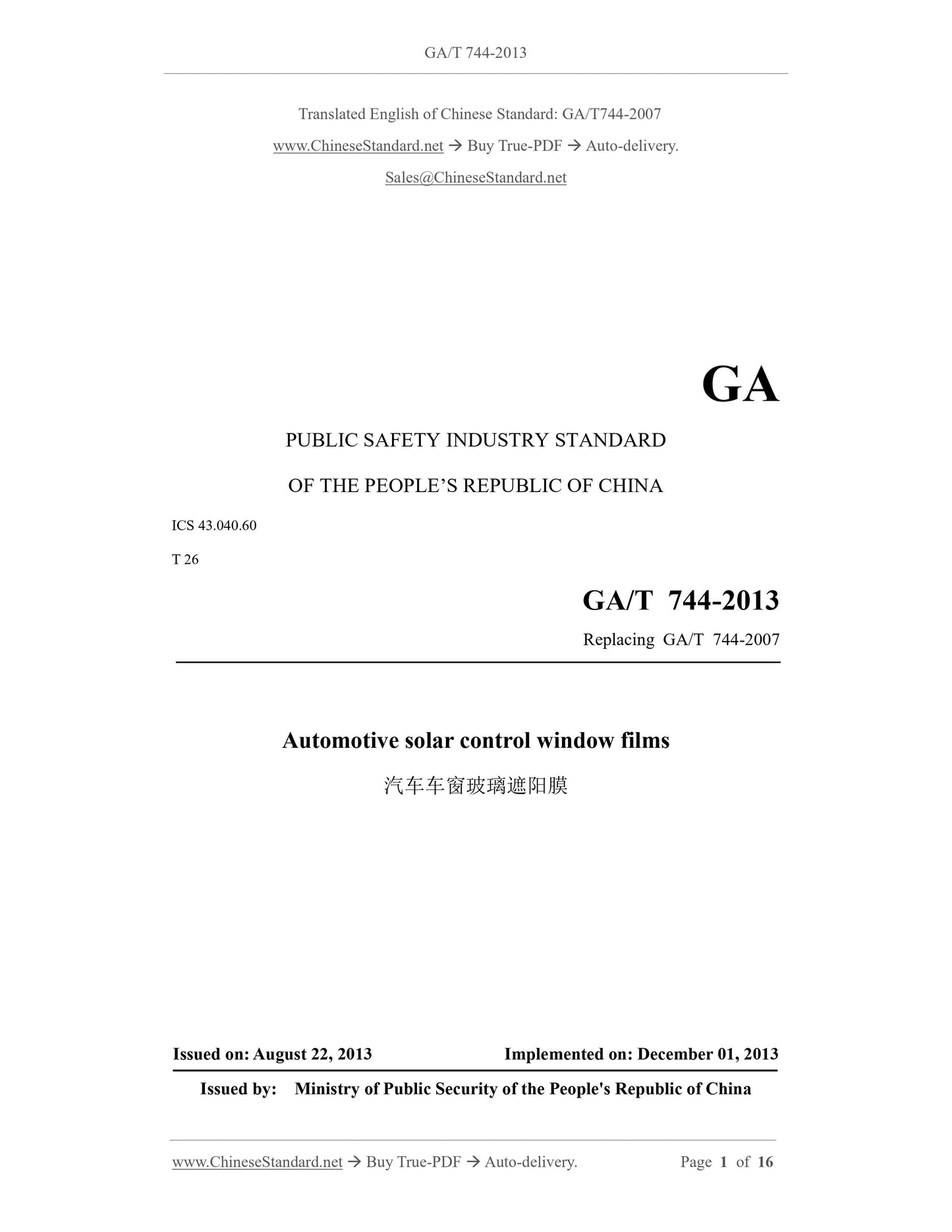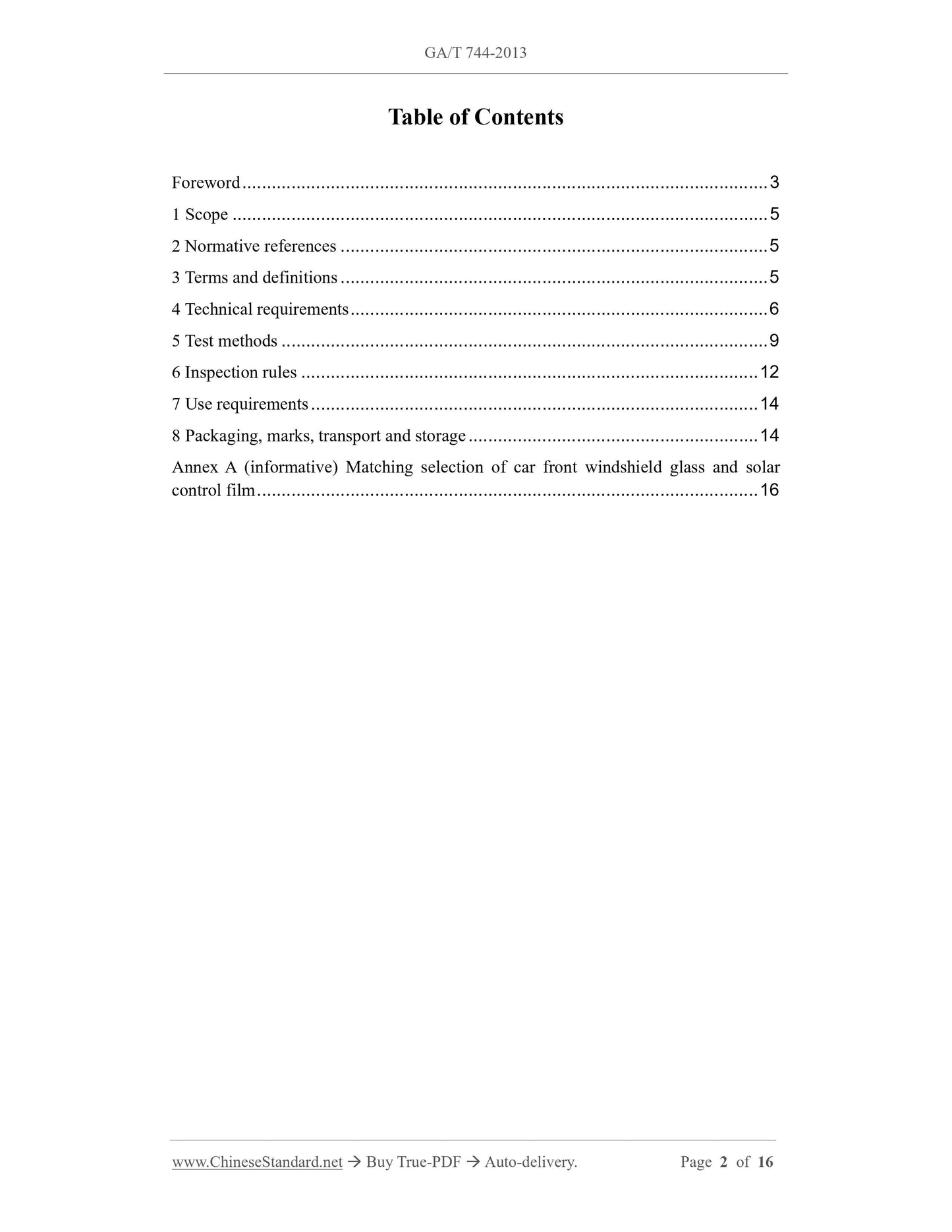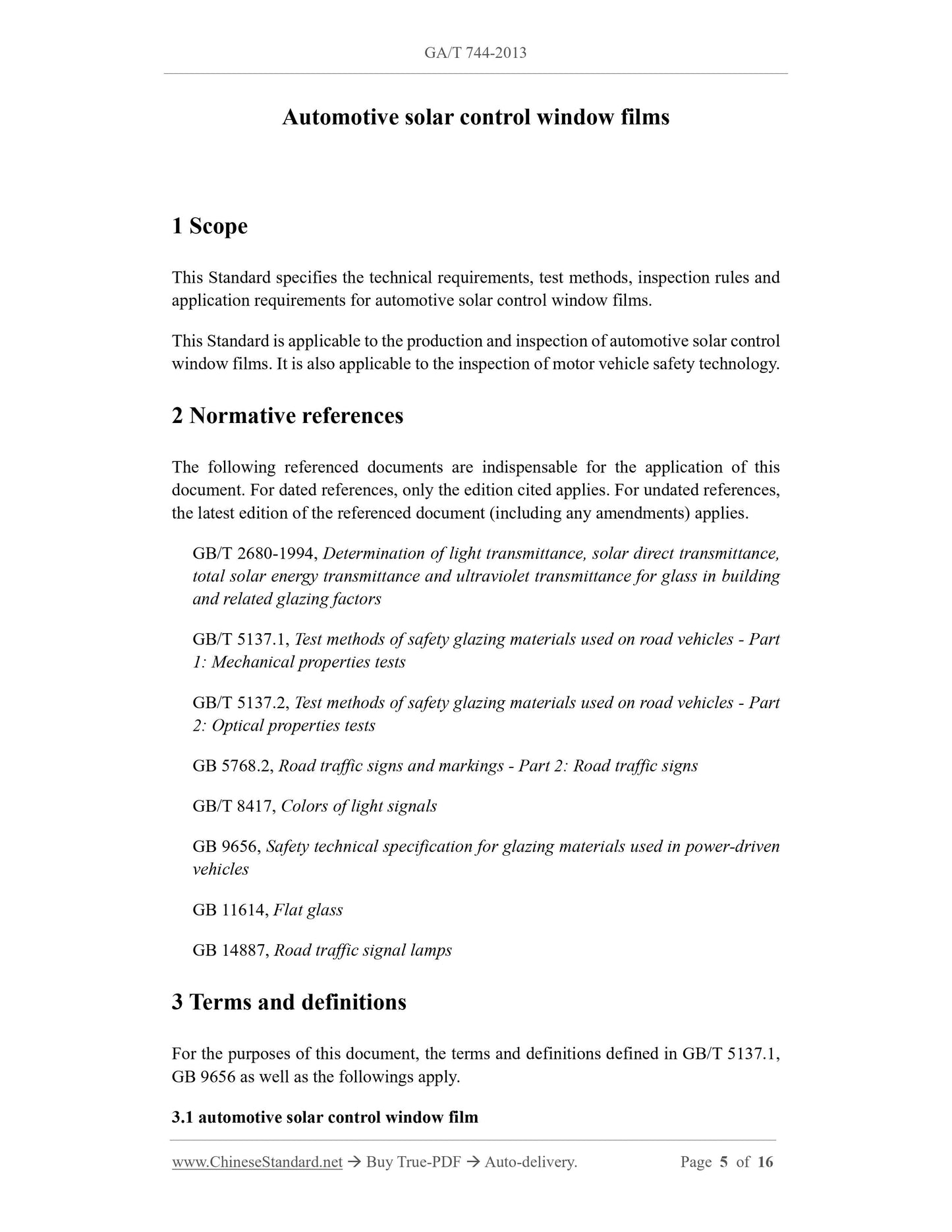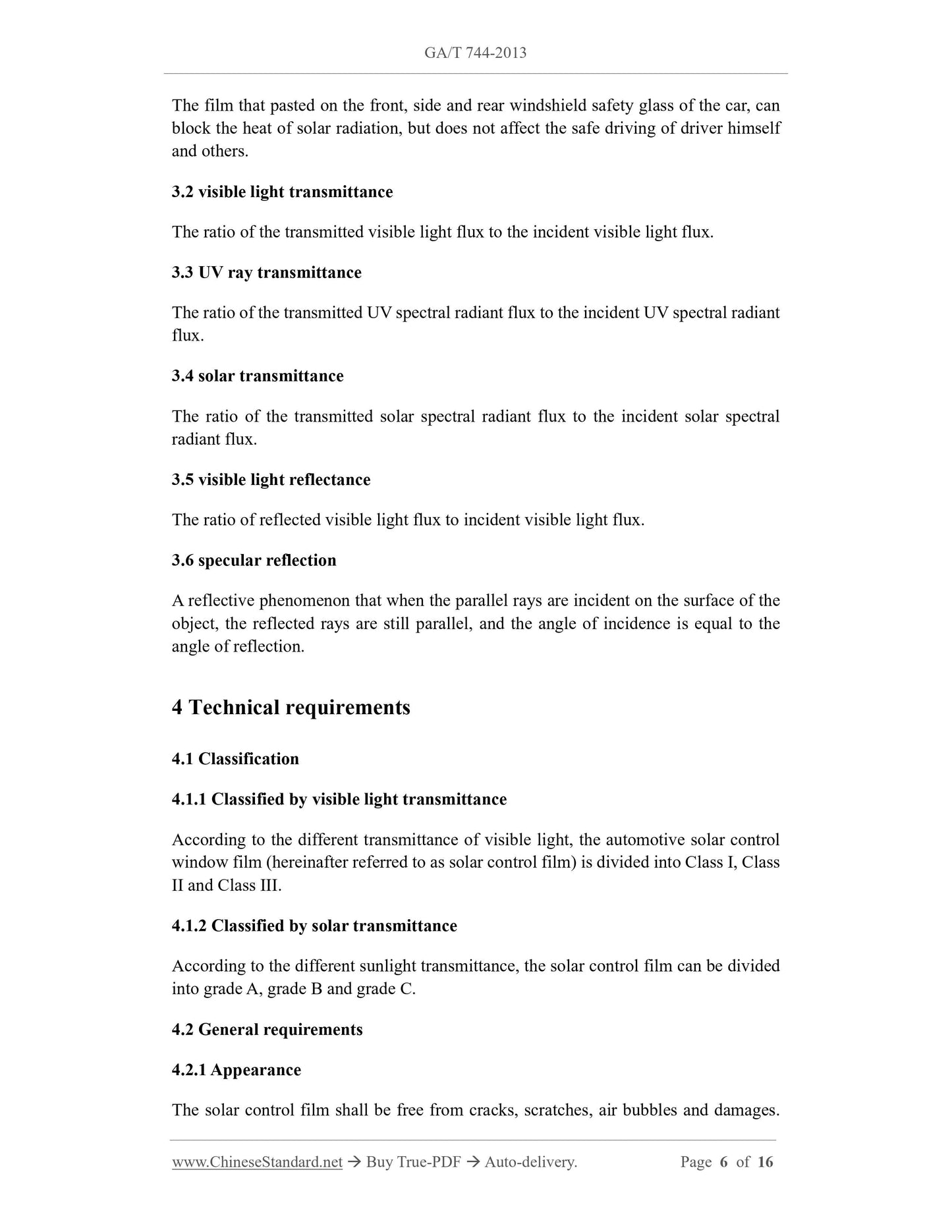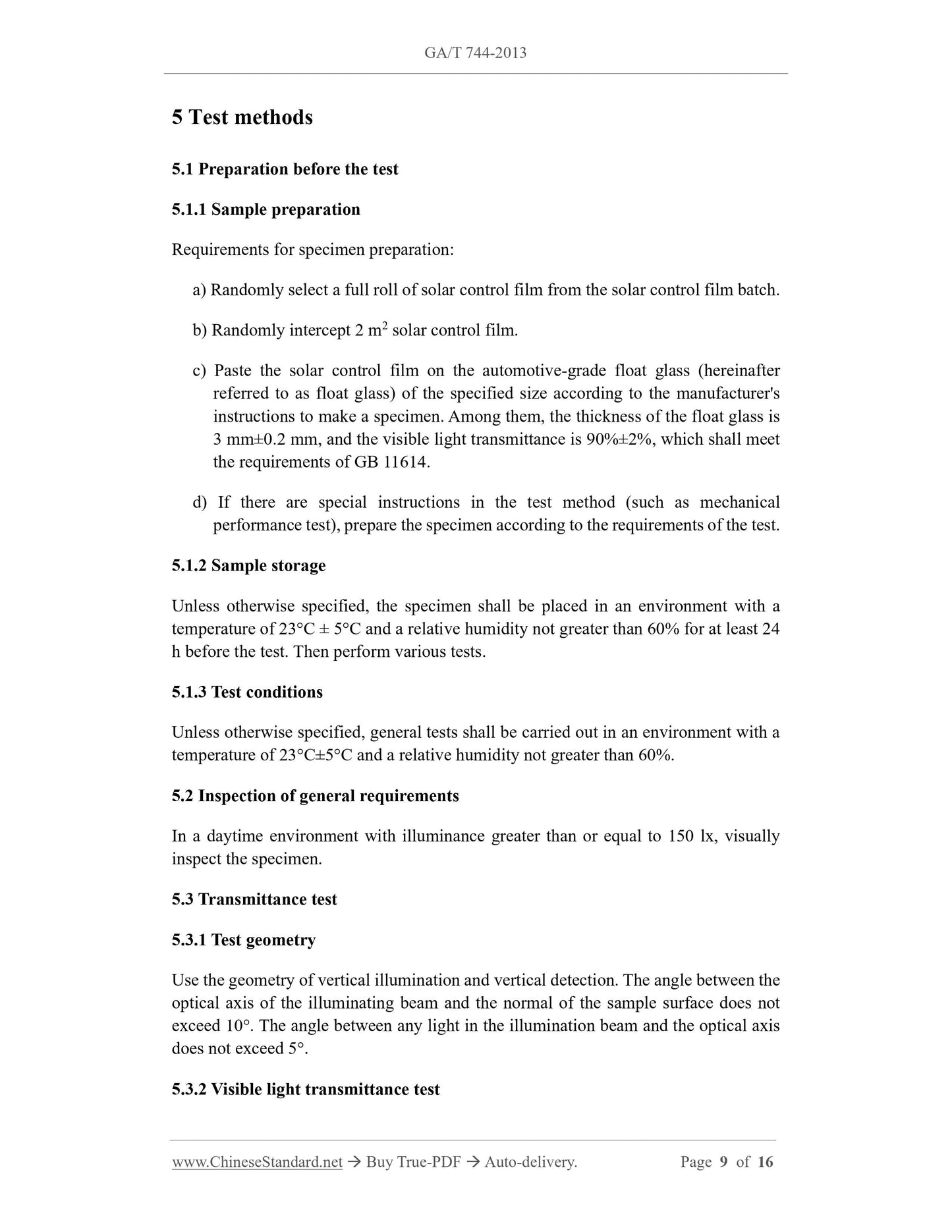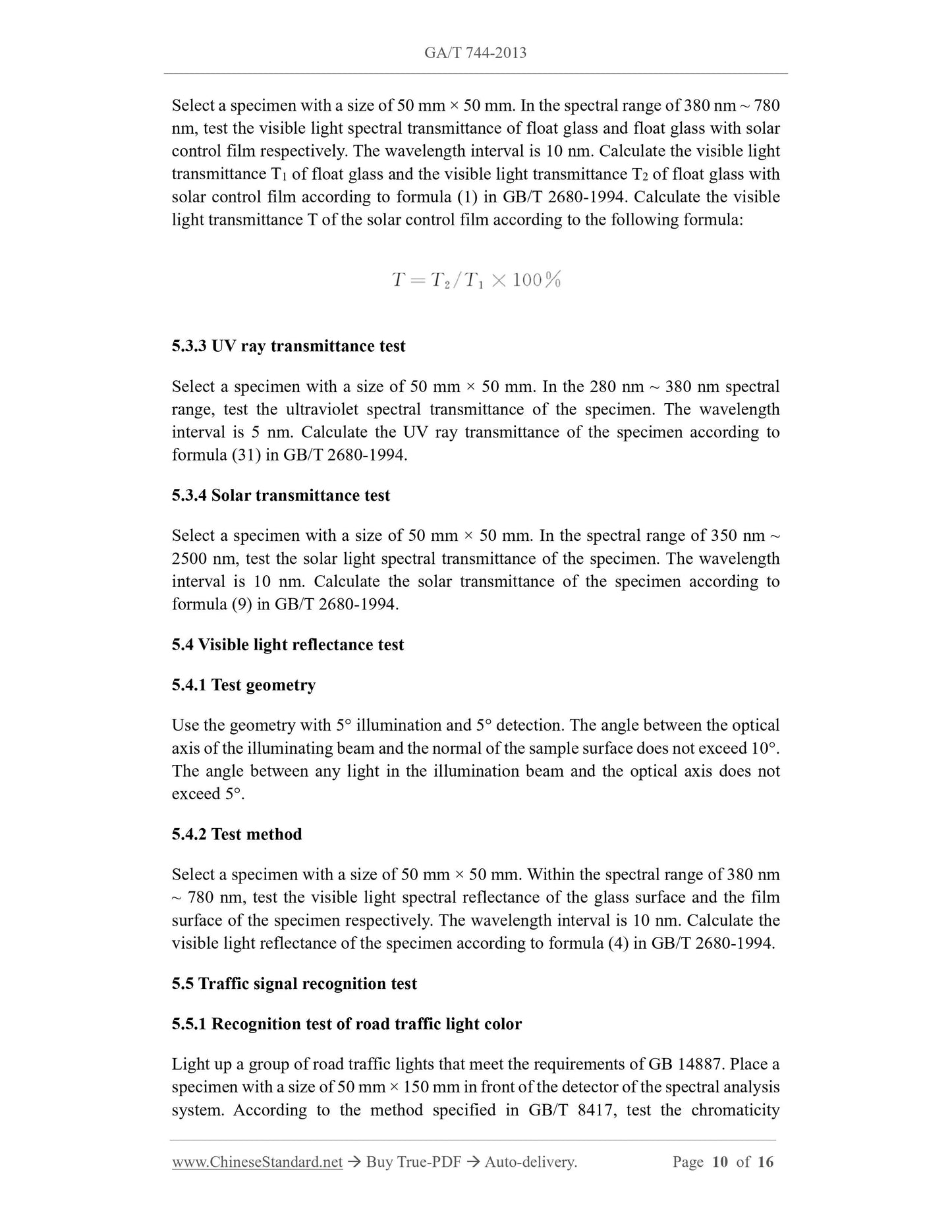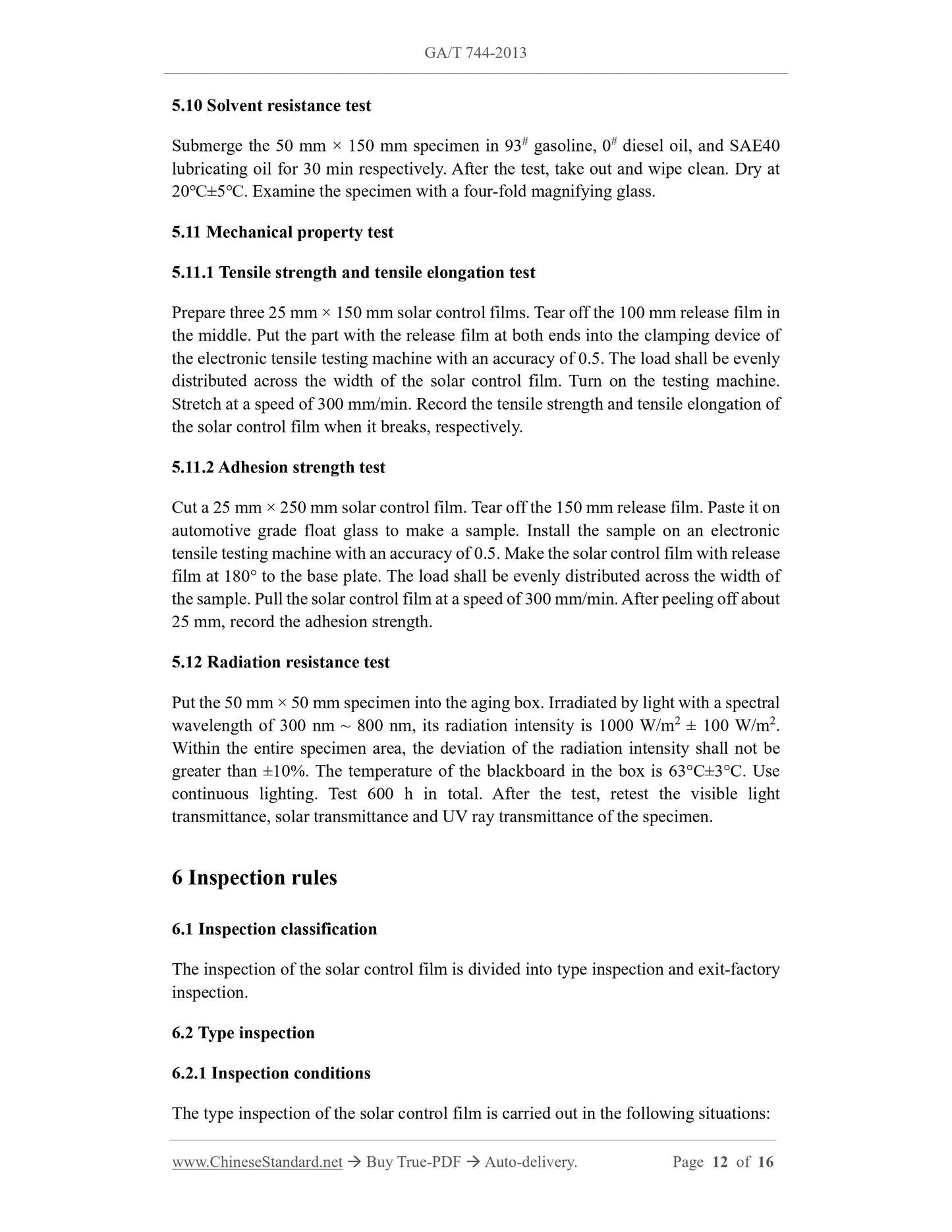PayPal, credit cards. Download editable-PDF & invoice In 1 second!
GA/T 744-2013 English PDF (GAT744-2013)
GA/T 744-2013 English PDF (GAT744-2013)
Precio habitual
$105.00 USD
Precio habitual
Precio de oferta
$105.00 USD
Precio unitario
/
por
Los gastos de envío se calculan en la pantalla de pago.
No se pudo cargar la disponibilidad de retiro
Delivery: 3 seconds. Download true-PDF + Invoice.
Get QUOTATION in 1-minute: Click GA/T 744-2013
Historical versions: GA/T 744-2013
Preview True-PDF (Reload/Scroll if blank)
GA/T 744-2013: Automotive solar control window films
GA/T 744-2013
GA
PUBLIC SAFETY INDUSTRY STANDARD
OF THE PEOPLE’S REPUBLIC OF CHINA
ICS 43.040.60
T 26
Replacing GA/T 744-2007
Automotive solar control window films
ISSUED ON: AUGUST 22, 2013
IMPLEMENTED ON: DECEMBER 01, 2013
Issued by: Ministry of Public Security of the People's Republic of China
Table of Contents
Foreword ... 3
1 Scope ... 5
2 Normative references ... 5
3 Terms and definitions ... 5
4 Technical requirements ... 6
5 Test methods ... 9
6 Inspection rules ... 12
7 Use requirements ... 14
8 Packaging, marks, transport and storage ... 14
Annex A (informative) Matching selection of car front windshield glass and solar
control film ... 16
Automotive solar control window films
1 Scope
This Standard specifies the technical requirements, test methods, inspection rules and
application requirements for automotive solar control window films.
This Standard is applicable to the production and inspection of automotive solar control
window films. It is also applicable to the inspection of motor vehicle safety technology.
2 Normative references
The following referenced documents are indispensable for the application of this
document. For dated references, only the edition cited applies. For undated references,
the latest edition of the referenced document (including any amendments) applies.
GB/T 2680-1994, Determination of light transmittance, solar direct transmittance,
total solar energy transmittance and ultraviolet transmittance for glass in building
and related glazing factors
GB/T 5137.1, Test methods of safety glazing materials used on road vehicles - Part
1: Mechanical properties tests
GB/T 5137.2, Test methods of safety glazing materials used on road vehicles - Part
2: Optical properties tests
GB 5768.2, Road traffic signs and markings - Part 2: Road traffic signs
GB/T 8417, Colors of light signals
GB 9656, Safety technical specification for glazing materials used in power-driven
vehicles
GB 11614, Flat glass
GB 14887, Road traffic signal lamps
3 Terms and definitions
For the purposes of this document, the terms and definitions defined in GB/T 5137.1,
GB 9656 as well as the followings apply.
3.1 automotive solar control window film
The film that pasted on the front, side and rear windshield safety glass of the car, can
block the heat of solar radiation, but does not affect the safe driving of driver himself
and others.
3.2 visible light transmittance
The ratio of the transmitted visible light flux to the incident visible light flux.
3.3 UV ray transmittance
The ratio of the transmitted UV spectral radiant flux to the incident UV spectral radiant
flux.
3.4 solar transmittance
The ratio of the transmitted solar spectral radiant flux to the incident solar spectral
radiant flux.
3.5 visible light reflectance
The ratio of reflected visible light flux to incident visible light flux.
3.6 specular reflection
A reflective phenomenon that when the parallel rays are incident on the surface of the
object, the reflected rays are still parallel, and the angle of incidence is equal to the
angle of reflection.
4 Technical requirements
4.1 Classification
4.1.1 Classified by visible light transmittance
According to the different transmittance of visible light, the automotive solar control
window film (hereinafter referred to as solar control film) is divided into Class I, Class
II and Class III.
4.1.2 Classified by solar transmittance
According to the different sunlight transmittance, the solar control film can be divided
into grade A, grade B and grade C.
4.2 General requirements
4.2.1 Appearance
The solar control film shall be free from cracks, scratches, air bubbles and damages.
5 Test methods
5.1 Preparation before the test
5.1.1 Sample preparation
Requirements for specimen preparation:
a) Randomly select a full roll of solar control film from the solar control film batch.
b) Randomly intercept 2 m2 solar control film.
c) Paste the solar control film on the automotive-grade float glass (hereinafter
referred to as float glass) of the specified size according to the manufacturer's
instructions to make a specimen. Among them, the thickness of the float glass is
3 mm±0.2 mm, and the visible light transmittance is 90%±2%, which shall meet
the requirements of GB 11614.
d) If there are special instructions in the test method (such as mechanical
performance test), prepare the specimen according to the requirements of the test.
5.1.2 Sample storage
Unless otherwise specified, the specimen shall be placed in an environment with a
temperature of 23°C ± 5°C and a relative humidity not greater than 60% for at least 24
h before the test. Then perform various tests.
5.1.3 Test conditions
Unless otherwise specified, general tests shall be carried out in an environment with a
temperature of 23°C±5°C and a relative humidity not greater than 60%.
5.2 Inspection of general requirements
In a daytime environment with illuminance greater than or equal to 150 lx, visually
inspect the specimen.
5.3 Transmittance test
5.3.1 Test geometry
Use the geometry of vertical illumination and vertical detection. The angle between the
optical axis of the illuminating beam and the normal of the sample surface does not
exceed 10°. The angle between any light in the illumination beam and the optical axis
does not exceed 5°.
5.3.2 Visible light transmittance test
Select a specimen with a size of 50 mm × 50 mm. In the spectral range of 380 nm ~ 780
nm, test the visible light spectral transmittance of float glass and float glass with solar
control film respectively. The wavelength interval is 10 nm. Calculate the visible light
transmittance T1 of float glass and the visible light transmittance T2 of float glass with
solar control film according to formula (1) in GB/T 2680-1994. Calculate the visible
light transmittance T of the solar control film according to the following formula:
5.3.3 UV ray transmittance test
Select a specimen with a size of 50 mm × 50 mm. In the 280 nm ~ 380 nm spectral
range, test the ultraviolet spectral transmittance of the specimen. The wavelength
interval is 5 nm. Calculate the UV ray transmittance of the specimen according to
formula (31) in GB/T 2680-1994.
5.3.4 Solar transmittance test
Select a specimen with a size of 50 mm × 50 mm. In the spectral range of 350 nm ~
2500 nm, test the solar light spectral transmittance of the specimen. The wavelength
interval is 10 nm. Calculate the solar transmittance of the specimen according to
formula (9) in GB/T 2680-1994.
5.4 Visible light reflectance test
5.4.1 Test geometry
Use the geometry with 5° illumination and 5° detection. The angle between the optical
axis of the illuminating beam and the normal of the sample surface does not exceed 10°.
The angle between any light in the illumination beam and the optical axis does not
exceed 5°.
5.4.2 Test method
Select a specimen with a size of 50 mm × 50 mm. Within the spectral range of 380 nm
~ 780 nm, test the visible light spectral reflectance of the glass surface and the film
surface of the specimen respectively. The wavelength interval is 10 nm. Calculate the
visible light reflectance of the specimen according to formula (4) in GB/T 2680-1994.
5.5 Traffic signal recognition test
5.5.1 Recognition test of road traffic light color
Light up a group of road traffic lights that meet the requirements of GB ...
Get QUOTATION in 1-minute: Click GA/T 744-2013
Historical versions: GA/T 744-2013
Preview True-PDF (Reload/Scroll if blank)
GA/T 744-2013: Automotive solar control window films
GA/T 744-2013
GA
PUBLIC SAFETY INDUSTRY STANDARD
OF THE PEOPLE’S REPUBLIC OF CHINA
ICS 43.040.60
T 26
Replacing GA/T 744-2007
Automotive solar control window films
ISSUED ON: AUGUST 22, 2013
IMPLEMENTED ON: DECEMBER 01, 2013
Issued by: Ministry of Public Security of the People's Republic of China
Table of Contents
Foreword ... 3
1 Scope ... 5
2 Normative references ... 5
3 Terms and definitions ... 5
4 Technical requirements ... 6
5 Test methods ... 9
6 Inspection rules ... 12
7 Use requirements ... 14
8 Packaging, marks, transport and storage ... 14
Annex A (informative) Matching selection of car front windshield glass and solar
control film ... 16
Automotive solar control window films
1 Scope
This Standard specifies the technical requirements, test methods, inspection rules and
application requirements for automotive solar control window films.
This Standard is applicable to the production and inspection of automotive solar control
window films. It is also applicable to the inspection of motor vehicle safety technology.
2 Normative references
The following referenced documents are indispensable for the application of this
document. For dated references, only the edition cited applies. For undated references,
the latest edition of the referenced document (including any amendments) applies.
GB/T 2680-1994, Determination of light transmittance, solar direct transmittance,
total solar energy transmittance and ultraviolet transmittance for glass in building
and related glazing factors
GB/T 5137.1, Test methods of safety glazing materials used on road vehicles - Part
1: Mechanical properties tests
GB/T 5137.2, Test methods of safety glazing materials used on road vehicles - Part
2: Optical properties tests
GB 5768.2, Road traffic signs and markings - Part 2: Road traffic signs
GB/T 8417, Colors of light signals
GB 9656, Safety technical specification for glazing materials used in power-driven
vehicles
GB 11614, Flat glass
GB 14887, Road traffic signal lamps
3 Terms and definitions
For the purposes of this document, the terms and definitions defined in GB/T 5137.1,
GB 9656 as well as the followings apply.
3.1 automotive solar control window film
The film that pasted on the front, side and rear windshield safety glass of the car, can
block the heat of solar radiation, but does not affect the safe driving of driver himself
and others.
3.2 visible light transmittance
The ratio of the transmitted visible light flux to the incident visible light flux.
3.3 UV ray transmittance
The ratio of the transmitted UV spectral radiant flux to the incident UV spectral radiant
flux.
3.4 solar transmittance
The ratio of the transmitted solar spectral radiant flux to the incident solar spectral
radiant flux.
3.5 visible light reflectance
The ratio of reflected visible light flux to incident visible light flux.
3.6 specular reflection
A reflective phenomenon that when the parallel rays are incident on the surface of the
object, the reflected rays are still parallel, and the angle of incidence is equal to the
angle of reflection.
4 Technical requirements
4.1 Classification
4.1.1 Classified by visible light transmittance
According to the different transmittance of visible light, the automotive solar control
window film (hereinafter referred to as solar control film) is divided into Class I, Class
II and Class III.
4.1.2 Classified by solar transmittance
According to the different sunlight transmittance, the solar control film can be divided
into grade A, grade B and grade C.
4.2 General requirements
4.2.1 Appearance
The solar control film shall be free from cracks, scratches, air bubbles and damages.
5 Test methods
5.1 Preparation before the test
5.1.1 Sample preparation
Requirements for specimen preparation:
a) Randomly select a full roll of solar control film from the solar control film batch.
b) Randomly intercept 2 m2 solar control film.
c) Paste the solar control film on the automotive-grade float glass (hereinafter
referred to as float glass) of the specified size according to the manufacturer's
instructions to make a specimen. Among them, the thickness of the float glass is
3 mm±0.2 mm, and the visible light transmittance is 90%±2%, which shall meet
the requirements of GB 11614.
d) If there are special instructions in the test method (such as mechanical
performance test), prepare the specimen according to the requirements of the test.
5.1.2 Sample storage
Unless otherwise specified, the specimen shall be placed in an environment with a
temperature of 23°C ± 5°C and a relative humidity not greater than 60% for at least 24
h before the test. Then perform various tests.
5.1.3 Test conditions
Unless otherwise specified, general tests shall be carried out in an environment with a
temperature of 23°C±5°C and a relative humidity not greater than 60%.
5.2 Inspection of general requirements
In a daytime environment with illuminance greater than or equal to 150 lx, visually
inspect the specimen.
5.3 Transmittance test
5.3.1 Test geometry
Use the geometry of vertical illumination and vertical detection. The angle between the
optical axis of the illuminating beam and the normal of the sample surface does not
exceed 10°. The angle between any light in the illumination beam and the optical axis
does not exceed 5°.
5.3.2 Visible light transmittance test
Select a specimen with a size of 50 mm × 50 mm. In the spectral range of 380 nm ~ 780
nm, test the visible light spectral transmittance of float glass and float glass with solar
control film respectively. The wavelength interval is 10 nm. Calculate the visible light
transmittance T1 of float glass and the visible light transmittance T2 of float glass with
solar control film according to formula (1) in GB/T 2680-1994. Calculate the visible
light transmittance T of the solar control film according to the following formula:
5.3.3 UV ray transmittance test
Select a specimen with a size of 50 mm × 50 mm. In the 280 nm ~ 380 nm spectral
range, test the ultraviolet spectral transmittance of the specimen. The wavelength
interval is 5 nm. Calculate the UV ray transmittance of the specimen according to
formula (31) in GB/T 2680-1994.
5.3.4 Solar transmittance test
Select a specimen with a size of 50 mm × 50 mm. In the spectral range of 350 nm ~
2500 nm, test the solar light spectral transmittance of the specimen. The wavelength
interval is 10 nm. Calculate the solar transmittance of the specimen according to
formula (9) in GB/T 2680-1994.
5.4 Visible light reflectance test
5.4.1 Test geometry
Use the geometry with 5° illumination and 5° detection. The angle between the optical
axis of the illuminating beam and the normal of the sample surface does not exceed 10°.
The angle between any light in the illumination beam and the optical axis does not
exceed 5°.
5.4.2 Test method
Select a specimen with a size of 50 mm × 50 mm. Within the spectral range of 380 nm
~ 780 nm, test the visible light spectral reflectance of the glass surface and the film
surface of the specimen respectively. The wavelength interval is 10 nm. Calculate the
visible light reflectance of the specimen according to formula (4) in GB/T 2680-1994.
5.5 Traffic signal recognition test
5.5.1 Recognition test of road traffic light color
Light up a group of road traffic lights that meet the requirements of GB ...
Share
